CMV
Platinum Member
So for not really knowing what I'm doing and getting 3 month's worth of rain in 1.5 weeks a little while ago, I'm happy with results from pumpkin growing experience so far. Picked a lot this week, a few weeks earlier than planned & think all that rain was reason. About 250 so far, probably ~75 left that aren't ready yet.

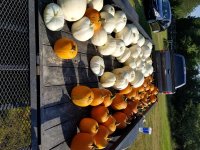
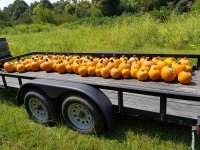
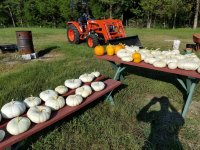
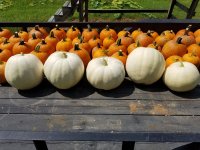
So since the patches are about done, now I need to know what to do with them. Have soil test kits to see what it needs in preparation for next year. So based on results will add whatever is required. I plan to enlarge the areas, but use the same spots for next year. I think that's a no-no and you aren't supposed to put same crop in same spot consecutive years, but really no choice since I'm limited on where I can put patches. THis is the smallest area I did this year after tilling:
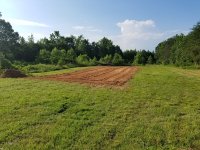
So here are the questions for now:
1. Once they are completely done producing in a few weeks, what do I do? Just bush hog & then till it up again?
2. Once I get results of soil tests, do I amend now or just prior to planting next year?
3. Should I plant anything or just let them grow weeds/grass until next year? Bush hog as short as possible, spray generic roundup, wait a couple days, broadcast spread granular fertilizer, till is what I did this year about a week prior to planting. So do that again next year? Or make them the size I want now by repeating those step this fall?
Bugs were a real problem! I broadcast spread spectracide granules (stuff from Lowe's for lawns) prior to tilling. After plants got their true leaves and up until male blooms appeared, we sprinkled sevin dust every other week. After they had blooms, broadcast the spectracide granules again. Everything seemed ok, a few squash bugs and whatnot here & there, but thought I had them under control. But EVERY pumpkin I picked had an entire ant colony under it (probably not hurting anything other than biting me for disturbing them), but lots had baby squash bugs, something that bored tiny holes in the flesh leaving a good-looking but rotten on the inside pumpkin, cucumber beetles, etc. Lots of handles rotted away from vine borers. Basically all the "bad bugs" I thought I was controlling were thriving. With the amount of little lizards I have running around you'd think there wouldn't be a bug for miles, but they must not be good hunters So I need some ideas how to be more aggressive, yet still bee-friendly next year.
So I need some ideas how to be more aggressive, yet still bee-friendly next year.
Also think mulching after planting rows would be much better. Would having a tree service give me a few loads of chipped up trees be OK for that? Would keep the fruit from direct ground contact so seems like that would be better than lying in mud after rain. Then just till that in next fall. Would that be OK or chipped green trees bad idea?





So since the patches are about done, now I need to know what to do with them. Have soil test kits to see what it needs in preparation for next year. So based on results will add whatever is required. I plan to enlarge the areas, but use the same spots for next year. I think that's a no-no and you aren't supposed to put same crop in same spot consecutive years, but really no choice since I'm limited on where I can put patches. THis is the smallest area I did this year after tilling:

So here are the questions for now:
1. Once they are completely done producing in a few weeks, what do I do? Just bush hog & then till it up again?
2. Once I get results of soil tests, do I amend now or just prior to planting next year?
3. Should I plant anything or just let them grow weeds/grass until next year? Bush hog as short as possible, spray generic roundup, wait a couple days, broadcast spread granular fertilizer, till is what I did this year about a week prior to planting. So do that again next year? Or make them the size I want now by repeating those step this fall?
Bugs were a real problem! I broadcast spread spectracide granules (stuff from Lowe's for lawns) prior to tilling. After plants got their true leaves and up until male blooms appeared, we sprinkled sevin dust every other week. After they had blooms, broadcast the spectracide granules again. Everything seemed ok, a few squash bugs and whatnot here & there, but thought I had them under control. But EVERY pumpkin I picked had an entire ant colony under it (probably not hurting anything other than biting me for disturbing them), but lots had baby squash bugs, something that bored tiny holes in the flesh leaving a good-looking but rotten on the inside pumpkin, cucumber beetles, etc. Lots of handles rotted away from vine borers. Basically all the "bad bugs" I thought I was controlling were thriving. With the amount of little lizards I have running around you'd think there wouldn't be a bug for miles, but they must not be good hunters
Also think mulching after planting rows would be much better. Would having a tree service give me a few loads of chipped up trees be OK for that? Would keep the fruit from direct ground contact so seems like that would be better than lying in mud after rain. Then just till that in next fall. Would that be OK or chipped green trees bad idea?